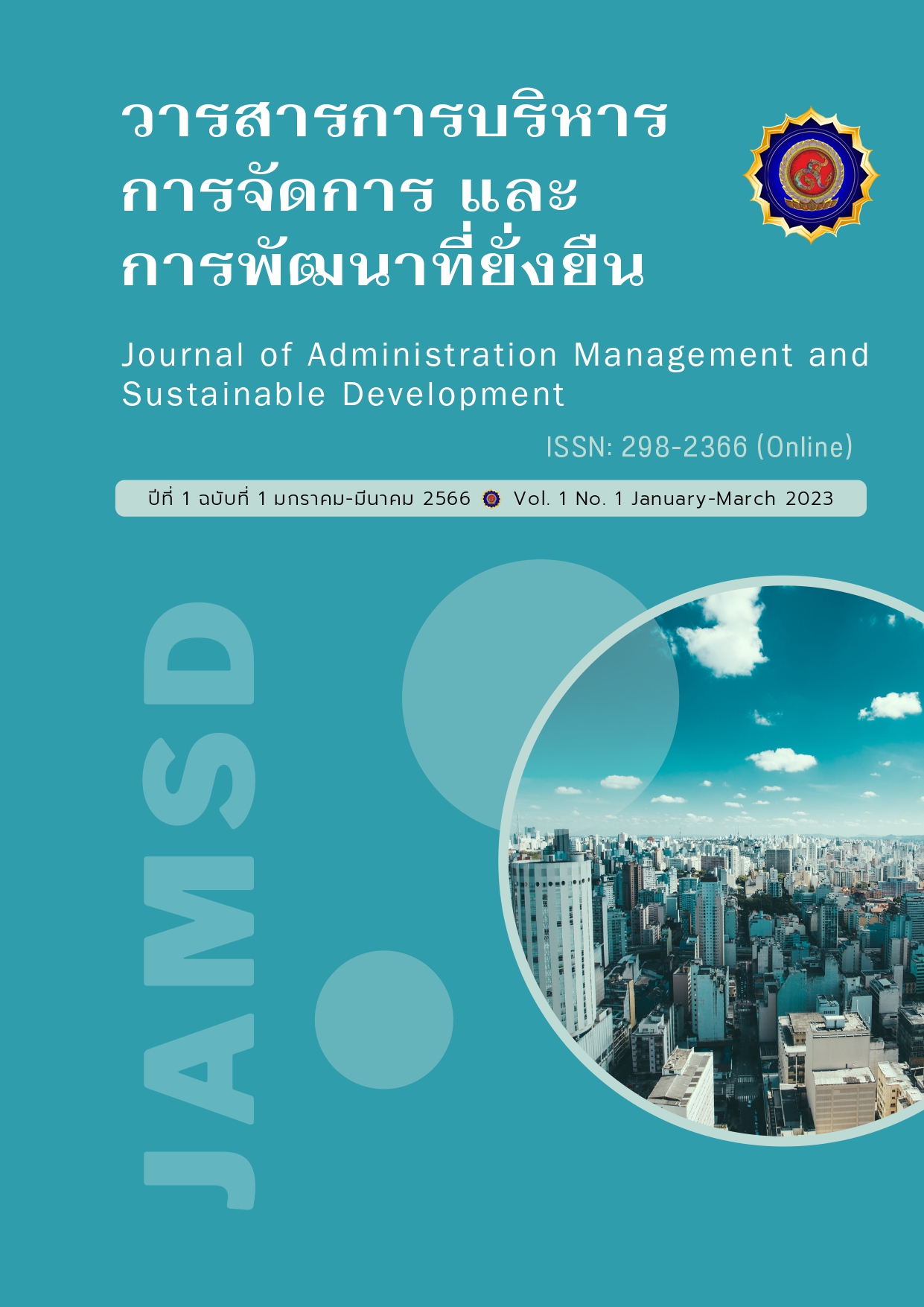Modern Work Motivation
Keywords:
Work motivation, ModernAbstract
This academic article's objective is to present motivation for modern work. Motivation to work Motivating the work of government personnel Theory and practice of motivation in the workplace for private sector employees Persuasion is the process by which surrounding stimuli stimulate a person. This can be divided as follows: 1. Content Theory Group This will cover the hierarchy of needs theory. Intrinsic and extrinsic motivation theories consist of 1) Abraham Maslow's Theory, 2) Two-Factor Theory, 3) Theory X and Theory Y, 4) ERG Theory, and 2) Group Theory of Process. Fairness theory and expectation theory, Including guidelines for motivation that are important in today's era, should be used in conjunction with work to achieve maximum efficiency.
References
อรพินทร์ ชูชม. (2555). แรงจูงใจในการทำงาน: ทฤษฎีและการประยุกต์. วารสารจิตวิทยา มหาวิทยาลัยเกษมบัณฑิต. 2(2) มกราคม-ธันวาคม 2555.
อรพินทร์ ชูชม, อัจฉรา สุขารมณ์และวิลาสลักษณ์ ชัววัลลี. (2542). การพัฒนาแบบวัดแรงจูงใจภายใน. กรุงเทพฯ: สถาบันวิจัยพฤติกรรมศาสตร์ มหาวิทยาลัยศรีนครินทรวิโรฒ.
อรพินทร์ ชูชม, อัจฉรา สุขารมณ์ และอังศินันท์ อินทรกำแหง.(2553). การวิเคราะห์ความสัมพันธ์ระหว่างครอบครัว งานกับคุณภาพชีวิต. วารสารพฤติกรรมศาสตร์, 16(2), 32-49.
จักรี ศรีจารุเมธีญาณ. (2560). การบริหารทรัพยากรมนุษย์ในภาครัฐ. ขอนแก่น : มหาวิทยาลัยมหามกุฎราชวิทยาลัย วิทยาเขตอีสาน.
ณัฏฐ์พัชร์ ลาภบำรุงวงศ์. (2562). การประยุกต์ทฤษฎีแรงจูงใจในการปฏิบัติงาน. วารสารวไลยอลงกรณ์ปริทัศน์ (มนุษยศาสตร์และสังคมศาสตร์), 9(2) พฤษภาคม-สิงหาคม 2562.
ปฐมวงค์ สีหาเสนา. (2557). แรงจูงใจในการปฏิบัติงานของบุคลากรเทศบาลตำบลค่ายเนินวง ตำบลบางกะจะอำเภอเมืองจันทบุรี จังหวัดจันทบุรี. หลักสูตรรัฐประศาสนศาสตรมหาบัณฑิต, มหาวิทยาลัยบูรพา.
จักรี ศรีจารุเมธีญาณ. (2563). แรงจูงใจในการทำงาน:ทฤษฎีและการประยุกต์ใช้. ขอนแก่น: มหาวิทยาลัยมหามกุฎราชวิทยาลัย วิทยาเขตอีสาน.
พิมสิริ ติยะโคตร. (2556). การสร้างแรงจูงใจในการทำงาน. สืบค้นจาก
https://sites.google.com/site/anthikabac/kar-srang-raeng-cungci-ni-kar-thangan
ชนิดา คุณทองคำ. (2556). แรงจูงใจในการปฏิบัติงานของบุคลากรสำนักงานการตรวจเงินแผ่นดินภูมิภาคที่ 2, ชลบุรี: มหาวิทยาลัยรามคำแหง.
Thanatporn Suthisansanee. (2012). ทฤษฎีมาสโลว์ ลำดับขั้นความต้องการ Maslow’s. สืบค้นจาก https://thewisdom.co/content/maslows-hierarchy-of-needs.
Digitized Company. (2563). วิธีการสร้างแรงบันดาลใจ ให้พนักงานในองค์กรของคุณเพื่อการทำงานที่ดีขึ้น. สืบค้นจาก https://www.ko.in.th/สร้างแรงบันดาลใจให้กับพนักงาน.
Sukhum Rattanasereekiat. (2012). ทฤษฎีของการจูงใจ (theories of motivation). สืบค้นจาก http://pmcexpert.com/-theories-of-motivation.
Zaeema Asrar Mohiuddin. (2018). แรงจูงใจเพิ่มประสิทธิภาพการทำงานของพนักงาน: การเปรียบเทียบ
พนักงานภาครัฐและเอกชนในปากีสถาน. วารสารวิจัยสังคมศาสตร์ก้าวหน้า, มหาวิทยาลัยการาจีราชวิทยาลัย วิทยาเขตอีสาน, 5(4).
Disley, P., Hatton, C., & Dagnan, D. (2009). Applying equity theory to staff working withindividuals with intellectual disabilities. Journal of Intellectual & Development Disability, 34(1), 55-66.
Frederick, W. Tr. (1911). The Principles of Scientific Management. New York: Harper and Brothers.
Herzberg,F., Bernard, M. & Snyderman, B. (1959). The Motivation to Work. New York: John Willey & Sons.
Amabile, T. M. (1993). Motivational synergy: Toward new conceptualization of intrinsic and extrinsic motivation in the workplace. Human Resource Management Review, 3(3), 185-201.
Barnes, S. J., & Pressed, A. D. (2012). Who needs real-life? Examining needs in virtual worlds. Journal of Computer Information Systems. 52(4), 40-48.
Latham, G. P., & Pinder, C. C. (2005). Work motivation theory and research at the dawn of the twenty-first century. Annual Review of Psychology, 56, 485-516.
layton, P. A. (1972). Existence, Relatedness & Growth: Human Needs in Organizational Setting. New York: The Free Press.
Loudon, D.L., & Bitta, D. A. J. (1988). Consumer Behavior: Concept and Applications(3rd ed). New York: McGraw-Hill.
Maslow, A.H. (1943). A Theory of Human Motivation. Psychological Review, p.370-396.
McGregor, D. (1960). The Human Side of Enterprise. New York: McGraw-Hill.
Pinder, C. (1998). Work Motivation in Organizational Behavior. Upper Saddle River, NJ: Prentice-Hall.
Gagne, M., & Deci, E. (2005). Self-determination theory and work motivation. Journal of Organizational Behavior. 26, 331-362.
Walter, K. (1978). The Working Class in Welfare Capitalism. London: Routledge & Kegan Paul.
Wahba, M. A., & Bridwell, L. G. (1973). Maslow reconsidered: A review of research on the need hierarchy theory. Academy of Management Proceedings. 514-520.






